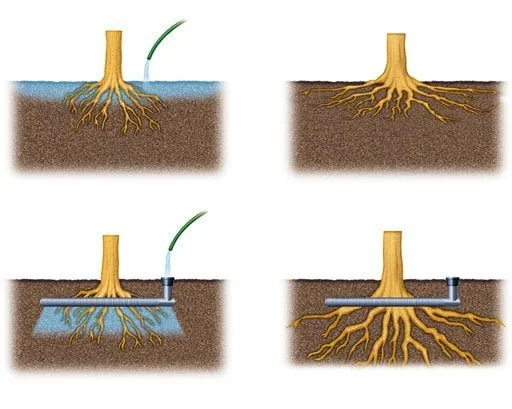Ensuring trees receive adequate water is essential for their health and growth, especially in areas prone to drought or hot summers. One effective method for maintaining tree health is deep watering. Deep watering trees involves:
- Providing water directly to the root zone.
- Encouraging profound root growth.
- Ensuring the tree can access moisture even during dry periods.
This guide will explore techniques and best practices for deep-watering trees to help you maintain a thriving landscape.
Understanding the Importance of Deep Watering
Deep watering trees is crucial because it promotes the development of deep, robust root systems. Shallow watering, which only wets the surface soil, can make shallow roots more susceptible to drought and wind damage. By providing water deep into the soil, you encourage roots to grow downward, making trees more resilient and able to access moisture and nutrients from deeper soil layers.
Timing and Frequency of Deep Watering
The timing and frequency of deep watering depend on several factors, including the type of tree, soil conditions, and climate. Generally, it is best to water trees early or late in the evening to minimize evaporation. Deep watering should be done less frequently but for longer durations to ensure the water penetrates deeply into the soil. A good rule of thumb is to water mature trees every two to four weeks, while newly planted trees may require more frequent watering until they establish their root systems.
Techniques for Deep Watering Trees
Several techniques can be used for deep watering trees, each with advantages. Here are some effective methods:
Soaker Hoses and Drip Irrigation

Soaker hoses and drip irrigation systems are excellent for deep watering as they deliver water slowly and directly to the root zone. These systems can be laid out around the tree’s drip line (the area directly under the outer circumference of the tree’s branches) to ensure even distribution. Drip irrigation systems can be set on timers to provide consistent moisture without overwatering.
Deep Root Watering Devices

Deep root watering devices, such as tree watering stakes or probes, are designed to deliver water directly to the root zone. These devices can be inserted 12 to 18 inches into the soil, allowing water to reach deep roots effectively. They are instrumental for more giant trees or those planted in compacted soils.
Manual Watering

For smaller trees or areas without irrigation systems, a garden hose can be used for manual watering. To deep water manually, place the hose at the base of the tree and let the water run slowly for an extended period, ensuring it soaks deep into the soil. A slow trickle over several hours is more effective than a quick, high-volume soak.
Best Practices for Deep Watering Trees
To ensure successful deep watering, follow these best practices:
Check Soil Moisture
Make sure the soil is not overwatered before watering. Use a soil moisture meter or dig a small hole near the tree to a 6-8 inches depth. Watering can be delayed if the soil is still moist. Deep watering should complement natural rainfall, not replace it.
Mulching
Applying a layer of mulch around the tree’s base helps retain soil moisture and regulate soil temperature. Organic mulches like wood chips, bark, or compost are ideal. Spread mulch in a 3-4 inch layer, extending to the tree’s drip line, but keep it a few inches away from the trunk to prevent rot.
Avoiding Overwatering
Overwatering can be as harmful as underwatering. Ensure that the soil has proper drainage to prevent water from pooling around the roots, which can lead to root rot. A sandy soil drains quickly and may require more frequent watering, while a clay soil retains moisture for longer periods.
Monitoring Tree Health
Monitor your trees regularly for signs of water stress, such as wilting, yellowing leaves, or slow growth. Adjust your watering schedule based on the tree’s condition and environmental factors. Newly planted trees require closer attention as they establish their root systems.
Seasonal Adjustments
Adjust your watering practices according to the season. Trees typically require more water during the growing season (spring and summer) and less during dormancy (fall and winter). Remember rainfall patterns and adjust your watering schedule to complement natural precipitation.

